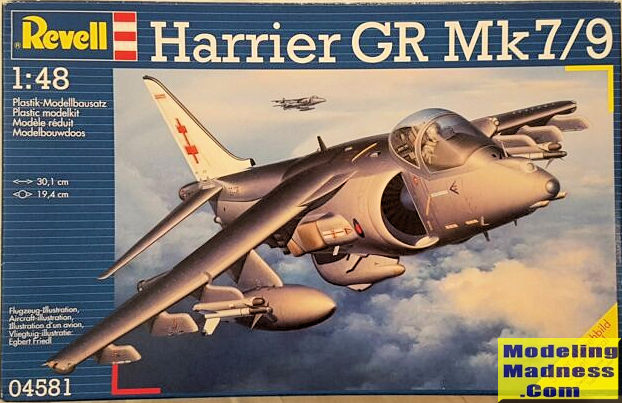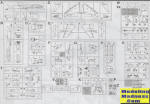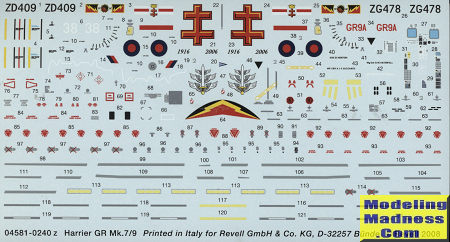
Revell(Hasegawa) 1/48 Harrier GR.7/9
| KIT #: | 04581 |
| PRICE: | I paid $30.00 |
| DECALS: | Three options |
| REVIEWER: | Scott Van Aken |
| NOTES: | Reboxed Hasegawa kit |

| HISTORY |
The British Aerospace Harrier II is a second-generation vertical/short takeoff and landing (V/STOL) jet aircraft used previously by the Royal Air Force (RAF) and, between 2006 and 2010, the Royal Navy (RN). The aircraft was the latest development of the Harrier Jump Jet family, and was derived from the McDonnell Douglas AV-8B Harrier II. Initial deliveries of the Harrier II were designated in service as Harrier GR5; subsequently upgraded airframes were redesignated accordingly as GR7 and GR9.
Under the Joint Force Harrier organisation, both the RAF and RN operated the Harrier II under the RAF's Air Command, including deployments on board the navy's Invincible class aircraft carriers. The Harrier II participated in numerous conflicts, making significant contributions in combat theatres such as Kosovo, Iraq, and Afghanistan. The type's main function was as a platform for air interdiction and close air support missions; the Harrier II was also used for presence projection and reconnaissance duties. The Harrier II served alongside the Sea Harrier in Joint Force Harrier.
In December 2010, budgetary pressures led to the early retirement of all Harrier IIs from service, at which point it was the last of the Harrier derivatives remaining in British service. The decision to retire was controversial as there was no immediate fixed-wing replacement in its role or fixed-wing carrier-capable aircraft left in service; in the long term the Harrier II is to be replaced by the Lockheed Martin F-35 Lightning II.
It was fortunate for the USMC that the RAF early retired its GR.7/9 aircraft as they bought the lot. This allowed spares for the fleet to remain operational longer than anticipated due to the development issues with the F-35B.
| THE KIT |
 Not surprising
is that this is a Hasegawa kit in a Revell Box. Both Revell and Italeri rebox a
lot of other people's kits with Revell having a history of turning to Hasegawa
for kits. Hasegawa has been known to rebox other people's kits (the line of
Dragon FW-190s comes to mind. Tamiya does more often and it is often Italeri or
ICM.
Not surprising
is that this is a Hasegawa kit in a Revell Box. Both Revell and Italeri rebox a
lot of other people's kits with Revell having a history of turning to Hasegawa
for kits. Hasegawa has been known to rebox other people's kits (the line of
Dragon FW-190s comes to mind. Tamiya does more often and it is often Italeri or
ICM.
So what do you get? Well, you get a lot of pieces as Hasegawa does a lot of Harrier variants so things like wing tips and noses are all separate items to deal with this. You get a nice cockpit with a reasonably well done seat. Decals are offered for instrument panels if you wish. The completed cockpit fits into the nose halves. Then the tip of the nose that is particular to the GR.7/9 is added.
The polycap holder for the exhaust is then built up and you have the option of building the intake vanes either flush as if the engine is running or drooping down at the top as it normally is at rest. The lower part of the main fuselage is separate and this along with the exhaust polycap holder and the engine face are trapped between the halves. Then the nose is attached, followed by the intake assemblies.
Attention moves to the wing tips, then the upper fuselage in fornt of the wing then the fin and landing gear. Upper and lower wing sections are glued then attached to the fuselage along with the wing tips, refueling probe and the tailplanes. One then attaches the gear and the speed brake. You can build up and install the cannon if you wish to use those in place of the strakes.
Then wing pylons and fuel tanks are built and installed along with missiles. No bombs are included so you'll have to source those elsewhere. The aircraft has a myriad of scoops that need installed along with antennas. Canopy is separate from the windscreen and can be posed open.
 Instructions are standard fare for Revell with Revell paint
numbers used during construction. Three options are provided with all of them in
the last scheme of dark sea grey over medium sea grey. Two are with 41 Squadron,
which is a shadow squadron just to keep the number alive. The aircraft are
actually assigned to the Fast Jet and Weapons Operational Evaluation Unit. The
third is with 4 Squadron. Decals are well done and include a lot of stencils.
Instructions are standard fare for Revell with Revell paint
numbers used during construction. Three options are provided with all of them in
the last scheme of dark sea grey over medium sea grey. Two are with 41 Squadron,
which is a shadow squadron just to keep the number alive. The aircraft are
actually assigned to the Fast Jet and Weapons Operational Evaluation Unit. The
third is with 4 Squadron. Decals are well done and include a lot of stencils.
| CONCLUSIONS |
Sometimes, when Revell reboxes a Hasegawa kit for the European market we get a less expensive kit than what a standard Hasegawa kit would run if imported. That is probably the case here as well as getting a nice Revell decal sheet to go along with it. What you don't get is a nice top opening box in which you can build the kit as Revell is too cheap to use anything other than those miserable end opening kit boxes.
| REFERENCES |
https://en.wikipedia.org/wiki/British_Aerospace_Harrier_II
October 2020
Copyright ModelingMadness.com. If you would like your product reviewed fairly and fairly
quickly, please
contact
the editor
or see other details in the
Note to
Contributors.
Back to the Main Page
Back to the Review Index Page
Back to the Previews Index Page